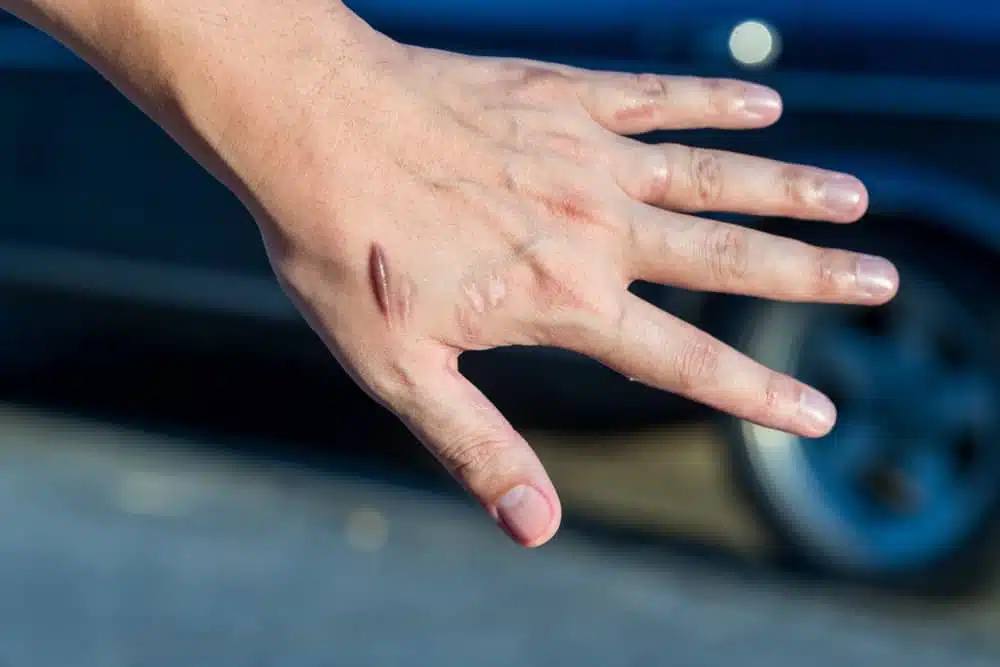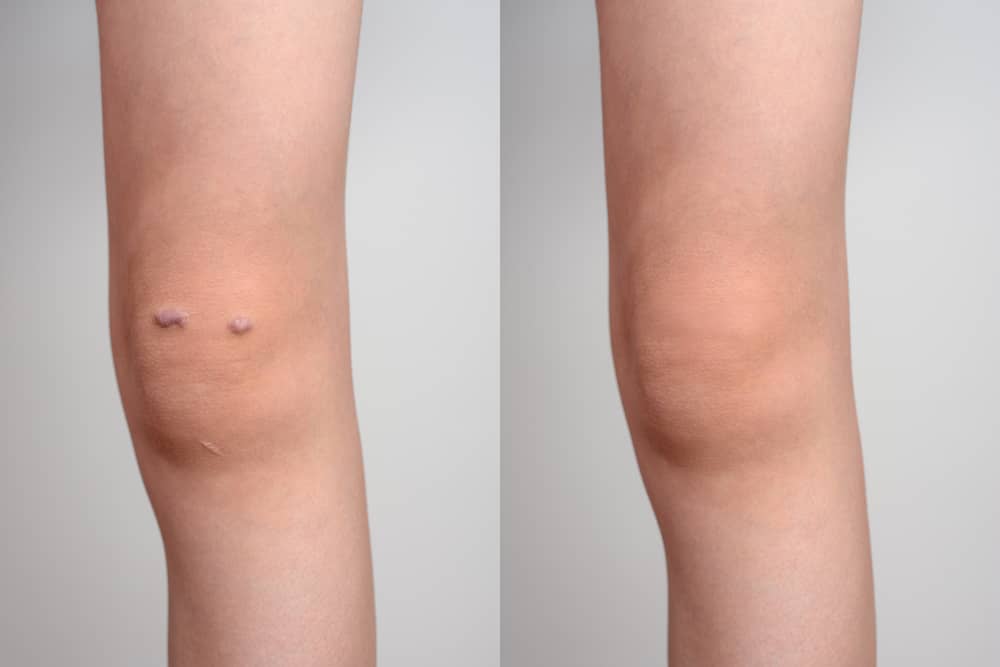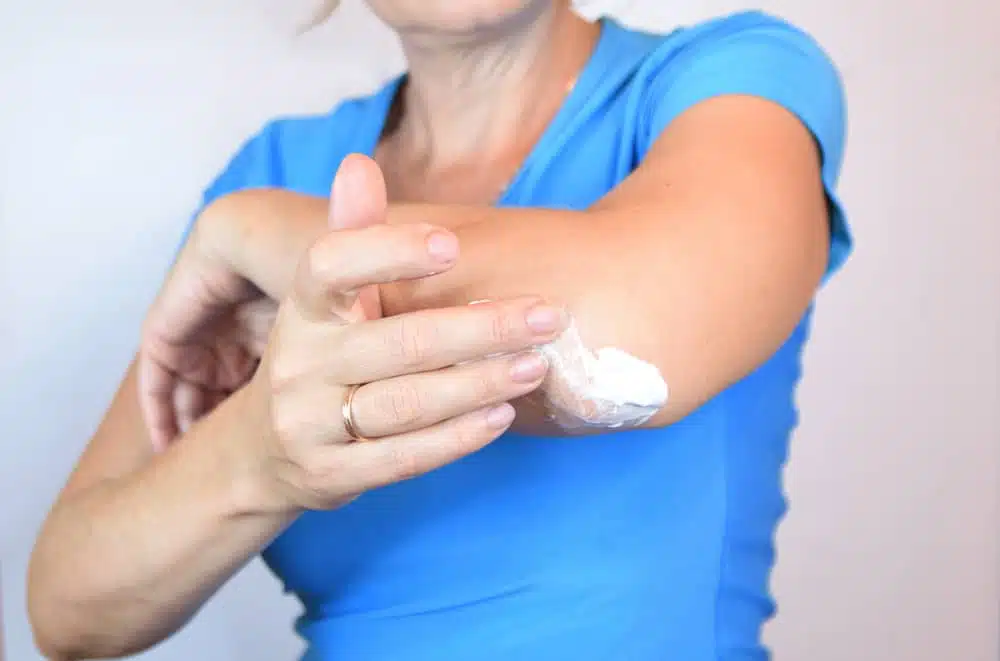Keloids and hypertrophic scars are an ugly reminder of surgery or injury; sometimes the resulting scarring can be much worse than the original injury! So you’ve decided to take action and pursue treatment for your scars. But the thought of keloid treatment side effects has you worried – what should you expect after keloid removal?
Don’t worry, in this article, I’ll explain how SRT, a specific type of scar therapy, might help alleviate some common discomforts associated with keloid removal. Plus I’ll give you tips on determining if it’s right for you.

What are the keloid symptoms?
Keloids are raised scar tissue that can cause a variety of symptoms. An overgrowth of collagen causes it at the site of injury. The most common symptoms associated with the development of a keloid are redness, itchiness, tenderness, and localized swelling. In some cases, the affected area may become sensitive to sunlight and hot or cold temperatures. Symptoms can vary in severity from mild to severe depending on the individual’s skin type and medical history.
In more extreme cases, keloids may result in discoloration of the skin and hair loss. In addition, keloids have been reported to cause abscesses, pain, discomfort, and even changes in sensation when touched or rubbed against clothing. As keloids could also be accompanied by infection or ulceration of tissue around it, proper care should be taken to avoid aggravating the condition.
Why do keloids appear?
Keloids are a type of abnormal scar tissue that develops after an injury, infection, or surgery. While the exact cause for this excessive and abnormal scarring is not known, genetic predisposition does appear to play a role. Sun exposure can also cause keloid scars as underlying inflammatory conditions or skin diseases. People who are prone to developing keloids have been shown to have unusual characteristics in their collagen, which is responsible for how scars form.
Other possible factors which might contribute to making someone more susceptible to the development of keloids include hormones, ethnicity, and age – people aged 10-30 are particularly at risk.
People with dark skin tones are particularly susceptible to the condition, due to higher levels of melanin in their skin. Ethnicities with darker skin tones, such as those of Southern Asian and African heritage, are more likely to be diagnosed with keloids than those with lighter tones. It’s also important to keep in mind that anyone can be affected by keloid scars, regardless of skin tone or ethnicity.
While there is still so much unknown about why some people may develop keloid scars and not others, you must be aware of your risks and take measures to ensure any injuries or operations don’t result in excess scarring down the road.
How to treat keloids?
Keloids are hardened patches of fibrous tissue that form near a wound that won’t heal. Treating them can be tricky, which is why it’s important to understand the side effects that may come with different treatment methods.
One of the treatments for keloids is the use of silicone sheets and pressure dressings. Silicone sheets are placed over the affected area to reduce inflammation and help flatten the scar tissue. Pressure dressings can also be used to help reduce the size of a keloid, as well as improve skin texture. For more difficult cases, hypertrophic scarring may require additional treatments such as steroid injections or laser therapy.
However, these treatments of keloid should only be used after consulting with a doctor to ensure that they are safe and effective for your particular case. With proper care and treatment, it is possible to reduce the appearance of keloids and improve skin texture.
Keloids Removal Surgery
Surgery is an effective treatment of keloid and hypertrophic scars, however, some of the scarring can persist in some cases as keloids naturally form when collagen does not correctly develop during healing. Infection is also possible after any type of surgery so it’s important to keep wounds clean and dry afterward.
The size of the keloid can also affect how long it takes to complete. Generally, larger keloids require more time and may take several hours to remove. During this procedure, a surgeon will carefully cut away the excess scar tissue while preserving as many blood vessels as possible. This helps reduce the risk of infection and ensures that the wound heals properly. After surgery, it is important to follow your doctor’s instructions for proper wound care to prevent any further complications or recurrence of keloid formation.
Keloids surgical removal is usually done under local anesthesia and involves cutting away the scar tissue. The procedure is often followed by a course of radiation therapy (SRT) to reduce the chances of keloid recurrence and treat difficult keloids.
SRT-100 for Keloids Removal
SRT-100, known as Keloid-focused radiotherapy, is a new non-invasive treatment for keloid removal and it also treats non-melanoma skin cancers. It has the potential to revolutionize how we approach keloids and it’s among the recommendations for scar management. SRT-100 skin cancer treatment releases energy in the form of radio waves that penetrate deeply into the tissue and that gently heat the surrounding area, while at the same time promoting natural healing processes.
The advantage of SRT keloid treatment Miami Beach is that it can provide effective treatments with very few side effects compared to other available treatments such as steroid injections or laser therapy. With an SRT treatment, patients may experience some redness, swelling, and itching during the procedure and for a short period afterward. However, these side effects are not generally long-lasting or severe enough to interfere with daily activities.
How does SRT for keloids works?
SRT-100 is designed to target the problem area without damaging healthy tissue nearby. This means that treatments are more effective and safer for patients, as it allows them to receive higher doses of radiation in a very localized area. This also helps to minimize the risk of any side effects spreading beyond the treatment area, making SRT-100 an ideal solution for treating keloids with less risk and fewer long-term adverse effects.
The cure rate for keloid removal using SRT-100 is very high. This is because SRT-100 targets only the affected area and does not damage normal tissues in the surrounding area. Additionally, radiation treatment helps to reduce the chances of recurrence by inhibiting collagen production, which can lead to further keloid formation.

Benefits of SRT for removal of keloids
Keloids treatment with the SRT-100 is a successful procedure in many body parts such as chest keloids. It has a lot of benefits if you are looking for a treatment performed by experts.
SRT is a non-surgical option to treat keloids
This treatment of keloids is a great option for those looking to avoid the risks associated with surgical incisions and keloid recurrence. The treatment helps to reduce collagen production, which can lead to further keloid formations. Additionally, SRT-100 is non-invasive and does not require any cutting or stitches, making it an ideal solution for those who want to avoid surgery.
SRT for keloids doesn’t damage healthy tissue
SRT-100 is a major innovation in scar management and provides an effective, non-invasive solution for keloid removal. Unlike other treatments that involve direct damage to the affected area, SRT-100 targets only the problem area without damaging healthy tissue nearby. This minimizes the risk of any side effects spreading beyond the treatment area and helps to ensure that healthy cells remain intact.
SRT is a quick procedure to treat keloids
SRT-100 is a quick and effective procedure for treating keloids, with treatments typically taking only a few hours. This makes it an ideal option for those who want to avoid the long hours of surgery associated with traditional keloid removal methods. Additionally, SRT-100 is highly effective in reducing keloid size and scars in persons, with clinical efficacy rates as high as 90%. This makes it an excellent choice for those looking for a safe and successful treatment that can help them achieve normal-looking skin.
SRT can treat small keloids
SRT-100 is an effective treatment for small keloids, such as those found on the earlobe. Studies have shown that SRT-100 has a high success rate among earlobe keloids, with up to 90% of patients reporting a reduction in size and scarring after treatment. Additionally, SRT-100 is a safe and non-invasive procedure that can provide relief from keloid symptoms. This makes it an ideal resort for those looking to treat their keloids without the risks associated with traditional treatments.
SRT has the best results
In the months after treatment, SRT-100 can have a positive effect on blood circulation and cellular response in the treated area. This helps to promote healthy tissue growth and reduce scarring, while also helping to reduce inflammation and pain associated with keloids. Additionally, SRT-100 has been shown to improve skin texture and tone, resulting in a more even complexion. With these benefits, SRT-100 is an effective and safe treatment option for those looking to treat their keloids without surgery or pain.
Side Effects of SRT for Keloids
While Superficial Radiation Therapy offers many advantages over other treatments such as steroid injections, surgery, or pulse dye laser treatment, it is important to be aware of the possible side effects associated with this type of keloid radiation therapy.
Common Side Effects of SRT for Keloids
The most common side effects include temporary redness and swelling at the treatment site, tenderness, itching, and a burning sensation. More serious side effects may include permanent discoloration of the treated area and skin thinning or loss.
It’s important to mention that because of SRT’s small size and high energy level, it has an increased risk of creating pigment changes in the skin that don’t resolve completely. This is why physicians may use other scar therapy treatments instead to treat certain patients with more sensitive skin.
Permanent Side Effects of SRT for Keloids
Permanent side effects of SRT for keloids can include discoloration of the treated area, skin thinning or loss, and scarring. These side effects are rare but can occur if the radiation therapy is not administered properly. Additionally, there is a risk of permanent pigment changes in the skin that do not resolve completely. This is why it is important to consult with a keloid expert before you have the procedure done.
Rare Side Effects of SRT for Keloids
In rare cases, more serious skin complications may occur due to SRT-100 such as infection or scarring. It is therefore important to discuss any concerns with your doctor before undergoing this type of treatment. This keloid scar treatment often offers excellent results when treating extremely large or persistent keloids.

Skincare advise after SRT for Keloids
After undergoing SRT-100 for keloids, it is important to follow your doctor’s clinical recommendations and use innovations in scar management. This includes using a specialized cream on the treated area to help reduce inflammation and promote healthy tissue growth. Additionally, it is important to keep the skin clean and moisturized to prevent infection and further scarring. With proper care and attention, patients can enjoy the benefits of SRT-100 with minimal side effects.
Schedule a consultation for a Combined Surgery and SRT
If you are wondering about SRT-100 treatment near me with excellent responses to treat your keloids without pain, schedule a consultation with us today. Dr. Mendez and Dr. Salloum can provide you with the information you need to make an informed decision about SRT-100’s benefits and its potential side effects. With our help, you can enjoy the benefits of this treatment with minimal risk. Contact us now to get started!